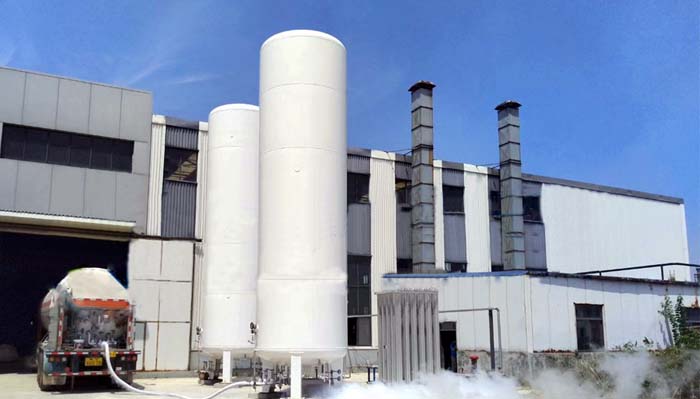Product Category
Abnormal frosting of valves and pipelines of liquid nitrogen storage tanks
Date: Mar 16, 2020

Factories should always check the liquid nitrogen storage tank for abnormal frost and other problems.
1. Protective equipment such as coarse cloth gloves should be worn during operation to prevent the liquid nitrogen storage tank from frostbite to human body.
2. Liquid nitrogen storage tanks Liquid storage containers are pressure vessels. Operators must undergo safety training, be familiar with the structure of liquid nitrogen storage tanks and the characteristics of cryogenic liquids, and master explosion-proof technology and fire safety regulations.
3. The pressure vessel operator should be familiar with the equipment process, the role and operation procedures of various valves, gauges and safety accessories, and the filling and draining should be performed strictly in accordance with the operating procedures.
4. In use, it should always be checked whether the valve of the storage tank is in the correct opening and closing position, whether the measurement of the pressure gauge and the liquid level gauge is accurate and reliable, and whether the pipelines and valves of the equipment are blocked. When the pressure of the storage tank reaches the take-off pressure of the safety valve and the safety valve does not move, the pressure of the safety valve should be calibrated immediately to ensure the safety of the low temperature liquid nitrogen storage tank.
5. The opening and closing of all storage tank valves should be slow to prevent excessive pressure from damaging the valves. When the valve freezes and cannot be opened and closed, it should be thawed with hot air or hot water. It is strictly prohibited to beat with hard objects, fire or electric heating. 6. If the pressure rise in the liquid nitrogen storage tank is abnormal, the gas vent valve should be opened immediately, and the cause should be identified to prevent accidents caused by overpressure.
6. If the pressure rise in the liquid nitrogen storage tank is abnormal, the gas vent valve should be opened immediately, and the cause should be identified to prevent accidents caused by overpressure.
7. When not in use for a short period of time, do not completely drain the liquid in the liquid nitrogen storage tank, and leave 5% to 10% of the liquid amount according to the length of the interrupted time to reduce the evaporation loss during refilling.
8. After the liquid nitrogen storage tank is emptied, the pressure in the storage tank should be maintained at 0.02MPa to prevent humid air from entering the pipeline system and causing pipeline valves to be blocked.
9. Pay attention to the phenomenon of "sweating" on the outer surface of the pressure vessel during operation. If "sweating" is found, stop using it and find out the cause.
10. The filling rate of liquid nitrogen storage tanks shall not be greater than 0.95, to prevent safety accidents caused by the sudden rise of the gas phase volume in the tank when the pressure is too small.
1. Protective equipment such as coarse cloth gloves should be worn during operation to prevent the liquid nitrogen storage tank from frostbite to human body.
2. Liquid nitrogen storage tanks Liquid storage containers are pressure vessels. Operators must undergo safety training, be familiar with the structure of liquid nitrogen storage tanks and the characteristics of cryogenic liquids, and master explosion-proof technology and fire safety regulations.
3. The pressure vessel operator should be familiar with the equipment process, the role and operation procedures of various valves, gauges and safety accessories, and the filling and draining should be performed strictly in accordance with the operating procedures.
4. In use, it should always be checked whether the valve of the storage tank is in the correct opening and closing position, whether the measurement of the pressure gauge and the liquid level gauge is accurate and reliable, and whether the pipelines and valves of the equipment are blocked. When the pressure of the storage tank reaches the take-off pressure of the safety valve and the safety valve does not move, the pressure of the safety valve should be calibrated immediately to ensure the safety of the low temperature liquid nitrogen storage tank.
5. The opening and closing of all storage tank valves should be slow to prevent excessive pressure from damaging the valves. When the valve freezes and cannot be opened and closed, it should be thawed with hot air or hot water. It is strictly prohibited to beat with hard objects, fire or electric heating.

7. When not in use for a short period of time, do not completely drain the liquid in the liquid nitrogen storage tank, and leave 5% to 10% of the liquid amount according to the length of the interrupted time to reduce the evaporation loss during refilling.
8. After the liquid nitrogen storage tank is emptied, the pressure in the storage tank should be maintained at 0.02MPa to prevent humid air from entering the pipeline system and causing pipeline valves to be blocked.
9. Pay attention to the phenomenon of "sweating" on the outer surface of the pressure vessel during operation. If "sweating" is found, stop using it and find out the cause.
10. The filling rate of liquid nitrogen storage tanks shall not be greater than 0.95, to prevent safety accidents caused by the sudden rise of the gas phase volume in the tank when the pressure is too small.
Send Your Inquiry
We not only provide a good product, but also provide high quality service. If you are interested in our products,
you can contact us in the following ways.
you can contact us in the following ways.







